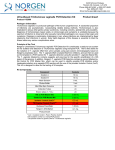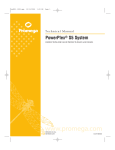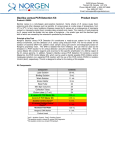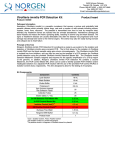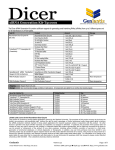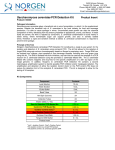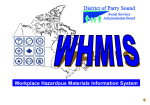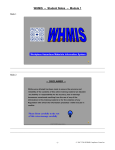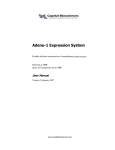Download Leptospira interrogans PCR Detection Kit
Transcript
3430 Schmon Parkway Thorold, ON, Canada L2V 4Y6 Phone: 866-667-4362 • (905) 227-8848 Fax: (905) 227-1061 Email: [email protected] Leptospira interrogans PCR Detection Kit Product Insert Product # 44600 Pathogen Information Leptospirosis is a disease of both humans and animals. The causal agent of the disease is the bacterium Leptospira interrogans. Leptospirosis is transmitted via contact with infected urine, venereal and placental transfer, bite wounds or ingestion. Indirect transmission may also occur through contaminated food, water or bedding. After infection the bacteria penetrate mucous membranes and multiply rapidly upon entering the blood system, spreading to other tissues including the kidneys, liver, spleen, nervous system, eyes and genital tract. Symptoms of acute infections include fever, shivering, muscle tenderness, vomiting and rapid dehydration. The disease is treatable with antibiotics, fluid replacement and anti-emetic drugs, as well as by controlling problems associated with the corresponding kidney and liver functions. Early rapid diagnosis of this disease is essential to treat the illness before any serious complications arise. Principle of the Test Norgen’s Leptospira interrogans PCR Detection Kit constituents a ready-to-use system for the isolation and detection of Leptospira interrogans using end-point PCR. The kit first allows for the isolation of Leptospira interrogans DNA from the urine samples using spin-column chromatography based on Norgen’s proprietary resin. The Leptospira interrogans DNA is isolated free from inhibitors, and can then be used as the template in a PCR reaction for Leptospira interrogans detection using the provided Leptospira interrogans Master Mix. The Leptospira interrogans Mastermix contains reagents and enzymes for the specific amplification of a 350 region of the genome. In addition, Norgen’s Leptospira interrogans PCR Detection contains a second Mastermix, the Control 2x PCR Master Mix, which can be used to identify possible PCR inhibition and/or inadequate isolation via a separate PCR reaction with the use of the provided Isolation Control (IsoC). This kit is designed to allow for the testing of 24 samples. Kit Components: Component Contents Solution A 10 mL Solution B 15 mL Wash Solution 9 mL Elution Buffer 3 mL Mini Filter Spin Columns 24 Collection Tubes 24 Elution tubes (1.7 mL) 24 LEP 2x PCR Master Mix 0.35 mL Control 2x PCR Master Mix 0.35 mL a Isolation Control (IsoC)* 0.3 mL b LEP Positive Control (PosC)* 0.1 mL Nuclease Free-Water 1.25 mL Norgen’s DNA Marker 0.1 mL Product Insert 1 * IsoC = Isolation Control ; PosC= Positive Control a b The isolation control is a cloned PCR product. The positive control is gnomic DNA of Leptospira interrogans Customer-Supplied Reagents and Equipment • Disposable powder-free gloves • Centrifuge with a swinging bucket rotor capable of 2000 RPM • Benchtop microcentrifuge • Micropipettors • Sterile pipette tips with filters • PCR tubes • Lysozyme • 96 – 100% ethanol • 60°C incubator • 15 mL tubes Storage Conditions and Product Stability All buffers should be kept tightly sealed and stored at room temperature (15-25oC) for up to 1 year without showing any reduction in performance. The LEP 2x PCR Master Mix, Control 2x PCR Master Mix, Isolation Control (IsoC) and the LEP Positive Control (PosC) should be kept tightly sealed and stored at -20oC for up to 1 year without showing any reduction in performance. Repeated thawing and freezing (> 2 x) should be avoided, as this may reduce the sensitivity. If the reagents are to be used only intermittently, they should be frozen in aliquots. General Precautions The user should exercise the following precautions when using the kit: • Use sterile pipette tips with filters. • Store and extract positive material (specimens, controls and amplicons) separately from all other reagents and add it to the reaction mix in a spatially separated facility. • Thaw all components thoroughly at room temperature before starting an assay. • When thawed, mix the components and centrifuge briefly. • Work quickly on ice. Quality Control In accordance with Norgen’s ISO 9001 and ISO 13485-certified Quality Management System, each lot of Norgen’s Leptospira interrogans PCR Detection Kit, including the LEP 2x PCR Master Mix, Control 2x PCR Master Mix, Isolation Control and LEP Positive Control are tested against predetermined specifications to ensure consistent product quality. Product Use Limitations Norgen’s Leptospira interrogans PCR Detection Kit is designed for research purposes only. Product Warranty and Satisfaction Guarantee NORGEN BIOTEK CORPORATION guarantees the performance of all products in the manner described in our product manual. The customer must determine the suitability of the product for its particular use. Disclaimers The Solution B contains guanidine hydrochloride, and should be handled with care. Guanidine hydrochloride forms highly reactive compounds when combined with bleach, thus care must be taken to properly dispose of any of these solutions. If liquid containing these solutions is spilt, clean with suitable laboratory detergent and water. If the spilt liquid contains potentially infectious agents, clean the affected area first with laboratory detergent and water, and then with 1% (v/v) sodium hypochlorite. Safety Information Ensure that a suitable lab coat, disposable gloves and protective goggles are worn when working with chemicals. For more information, please consult the appropriate Material Safety Data Sheets (MSDSs). These are available as convenient PDF files online at www.norgenbiotek.com. CAUTION: DO NOT add bleach or acidic solutions Leptectly to the sample-preparation waste. Protocol Important Notes Prior to Beginning Protocol: • All centrifugation steps are carried out in a benchtop microcentrifuge at 14,000 x g (~ 14,000 RPM) except where noted. All centrifugation steps are performed at room temperature. • A variable speed microcentrifuge should be used for maximum kit performance. If a variable speed centrifuge is not available a fixed speed centrifuge can be used, however reduced yields may be observed. • First time users should read the entire manual before proceeding with the protocol. • Do not spin down or filter the urine sample before proceeding with the isolation, as this could decrease the DNA yield. • Ensure that all solutions are at room temperature prior to use, and that no precipitates have formed. If necessary, warm the solutions and mix well until the solutions become clear again. • Prepare a working concentration of Wash Solution by adding 21 mL of 96-100% ethanol (provided by the user) respectively to the supplied bottle containing the concentrated Wash Solution. This will give a final volume of 30 mL. The label on the bottle has a box that can be checked to indicate that Isopropanol has been added. • Preheat an incubator or heating block to 60°C. • Prepare a 400 mg/mL stock solution (approximately 1.7 x107 units/mL) of lysozyme as per supplier's instructions. • Isolation Control (IsoC) A Isolation Control (IsoC) is supplied. This allows the user to control the DNA isolation procedure. For this assay, add the Isolation Control (IsoC) to the lysate during the isolation procedure The Isolation Control (IsoC) must not be added to the sample material directly . Do not freeze and thaw the Isolation Control (IsoC) more than 2 times. The Isolation Control (IsoC) must be kept on ice at all times during the isolation procedure. • The PCR components of the Leptospira interrogans PCR Detection Kit should remain at -20oC until DNA is extracted and ready for PCR amplification. • It is important to work quickly during this procedure. Specimen Collection and Sample Storage • Midstream urine samples should be collected, as the first flow of urine has been shown to have a higher rate of contamination (Morimoto et al., 2003). • It is highly recommended that urine samples be collected using Norgen’s Urine Collection and Preservation Tubes (Cat# 18111). The urine samples can be stored for at least one year at room temperature when collected directly using Norgen’s Urine Collection and Preservation Tubes. • Alternatively, urine samples collected using any other collection and preservation systems or reagents are also compatible with this kit. Sample Transport • Sample material should be transported in a shatterproof, leak-proof transport container as a matter of principle. Thus, a potential danger of infection due to a leakage of sample can be avoided. • The samples should be transported following the local and national instructions for the transport of pathogen material. A. Isolation of DNA 1. Add 300 µL of Solution A to 10 mL urine sample. Mix well by vortexing for 10 seconds. (Note 1: Solution A must be mixed well before every pipetting) 2. Centrifuge for 5 minutes at 2,000 RPM, then discard the supernatant carefully in order not to dislodge the precipitated slurry pellet. 3. Add 20 µL of the previously prepared lysozyme to the precipitated slurry pellet. Vortex for 10 seconds. Incubate the mixture at 60°°C for 20 minutes 4. Add 500 µL Solution B to the precipitated slurry pellet, mix well by vortexing for 10 seconds. 5. Add 10 µL Isolation Control (IsoC) to the mixture from Step 4. 6. Add 500 µL of 96-100% Ethanol to the mix from Step 5, mix well by vortexing for 10 seconds. 7. Transfer 650 µL from the previous mix into a Mini Filter Spin column and centrifuge for 1 minute at 14,000 RPM. Discard the flowthrough and reassemble the spin column with its collection tube. 8. Repeat Step 7 until the entire mixture from Step 6 has been transferred to the Mini Filter Spin Column. 9. Apply 400 µL of Wash Solution to the column and centrifuge for 1 minute. Discard the flowthrough and reassemble the spin column with its collection tube. 10. Repeat Step 9 to wash column second time. 11. Wash the column a third time by adding another 400 µL of Wash Solution to the column and centrifuge for 1 minute. Discard the flow-through and reassemble the spin column with its collection tube. 12. Spin the column for 2 minutes empty at 14,000 RPM in order to thoroughly dry the resin. Discard the collection tube. 13. Transfer the spin column to a fresh 1.7 mL Elution tube. Apply 100 µL of Elution Buffer to the column and centrifuge for 2 minutes at 2,000 RPM, followed by 1 minute at 14,000 RPM. B. Leptospira PCR Assay Preparation Notes: • Before use, suitable amounts of all PCR components should be completely thawed at room temperature, vortexed and centrifuged briefly. • The amount of LEP 2x PCR Master Mix and Control PCR Master Mix provided is enough for up to 32 PCR reactions (24 sample PCR, 4 positive control PCR and 4 no template control PCR). • For each sample, one PCR reaction using the LEP 2x PCR Mastermix and one PCR reaction using Control 2x PCR Mastermix should be set up in order to have a proper interpretation of the result. • For every PCR run, one reaction containing LEP Positive Control (PosC) and one reaction as no template control must be included for proper interpretation of results. • The recommended minimum number of DNA samples tested per PCR run is 6. • Using a lower volume from the sample than recommended may affect the sensitivity of Leptospira interrogans Limit of Detection. 1. Prepare the PCR for sample detection (Set #1, using LEP 2x PCR Mastermix) and control detection (Set #2, using Control 2x PCR Mastermix) as shown in Table 1 below. The recommended amount of sample DNA to be used is 2.5 µL. However, a volume between 1 and 5 µL of sample DNA may be used as template. Ensure that one LEP detection reaction and one control reaction is prepared for each DNA sample. Adjust the final volume of the PCR reaction to 20 µL using the Nuclease-Free Water provided. Table 1. PCR Assay Preparation PCR Components Volume Per PCR Reaction LEP 2x PCR Master Mix Or Control 2x PCR Master Mix 10 µL Sample DNA 2.5 µL Nuclease-Free Water 7.5 µL Total Volume 20 µL 2. For every PCR set, prepare one positive control PCR as shown in Table 2 below: Table 2. PCR Positive Control Preparation PCR Components Volume Per PCR Reaction LEP 2x PCR Master Mix Or Control 2x PCR Master Mix 10 µL LEP Positive Control (PosC) 10 µL Total Volume 20 µL 3. For every PCR set, prepare one no template control PCR as shown in Table 3 below: Table 3. PCR Negative Control Preparation PCR Components Volume Per PCR Reaction LEP 2x PCR Master Mix Or Control 2x PCR Master Mix 10 µL Nuclease-Free Water 10 µL Total Volume 20 µL C. Leptospira PCR Assay Programming 1. Program the thermocylcer according to the program shown in Table 4 below. 2. Run one step PCR. Table 4. Leptospira PCR Assay Program PCR Cycle Step Temperature Duration Cycle 1 Step 1 95oC 3 min Step 1 94oC 15 sec Step 2 58oC 15 sec Cycle 2 (35x) Step 3 o 30 sec o 72 C Cycle 3 Step 1 72 C 5 min Cycle 4 Step 1 4o C ∞ D. Leptospira PCR Assay Results Interpretation 1. For the analysis of the PCR data, the entire 20 µL PCR Reaction should be loaded on a 1X TAE 1.5% Agarose DNA gel along with 10 µL of Norgen’s DNA Marker (provided). 2. The PCR products should be resolved on the 1X TAE 1.5% Agarose gel at 150V for 30 minutes (Gel running time will be vary depending on an electrophoresis apparatus). 3. Sample results are provided below: M 1 2 3 4 5 6 7 8 NTC M Leptospira (350bp) Figure 1: A representative 1X TAE 1.5% agarose gel showing the amplification of Leptospira at different concentrations (Leptospira Target). The size of the Leptospira target amplicon corresponds to 350 bp as represented by the provided DNA Marker (M). NTC = Negative Control. M 1 2 3 4 5 6 NTC Isolation Control PCR Control Figure 2: A representative 1X TAE 1.5% agarose gel showing the amplification of Isolation Control and PCR Control under different conditions using the Control 2x PCR Mastermix. The size of the Isolation Control amplicon and PCR Control amplicon correspond to 499 bp and 150 bp, respectively, as represented by the provided DNA Marker (M). Lanes 1 to 5 showed detection of both Isolation Control and PCR Control, suggesting that the DNA isolation as well as the PCR reaction was successful. Lane 6 showed only the detection of PCR Control suggesting that while the PCR was successful, the isolation failed to recover even the spiked-in Isolation control. NTC = Negative Control. Table 5. Interpretation of PCR Assay Results Input Type Positive Control Target reaction Control Reaction Leptospira Target Band (350 bp) IsoC Band (499 bp) PCRC Band (150 bp) X X X Valid X Valid X X Positive X X Negative X Re-test Negative Control Sample Interpretation X Sample Sample Sample Re-test Sample X Sample X Sample X Sample X Negative X X Positive Positive Re-test ** For results obtained that are not covered in Table 5 above, please refer to the Troubleshooting Section. E. Leptospira PCR Assay Specificity and Sensitivity • The specificity of Norgen’s Leptospira interrogans PCR Detection Kit is first and foremost ensured by the selection of the Leptospira specific primers, as well as the selection of stringent reaction conditions. The Leptospira specific primers were checked for possible homologies to GenBank published sequences by sequence comparison analysis and published Leptospira strains. F. Linear Range • • • • The linear range of Norgen’s Leptospira interrogans PCR Detection Kit was determined by analysing a dilution series of a Leptospira quantification standards ranging from 1pg to 10 ng. Each dilution has been tested in replicates (n = 4) using Norgen’s Leptospira interrogans PCR Detection Kit on a 1X TAE 1.7% agarose gel. The linear range of Norgen’s Leptospira interrogans PCR Detection Kit has been determined to cover concentrations from 1pg to 10 ng. Under the conditions of the Norgen’s Leptospira DNA Isolation procedure, Norgen’s Leptospira interrogans PCR Detection Kit covers a linear range from 100 copies to 1 x 106 copies. Frequently Asked Questions 1. How many samples should be included per PCR run? • Norgen’s Leptospira interrogans PCR Detection Kit is designed to test 24 samples. For every 6 samples, a non-template control (Nuclease Free Water) and a Positive Control must be included. It is preferable to pool and test 6 samples at a time. If not, the provided Positive Control is enough to run 3 samples at a time. 2. How can I interpret my results if neither the PCR control nor the Isolation Control (IsoC) amplifies? • If neither the PCR control nor the Isolation Control (IsoC) amplifies, the sample must be re-tested. If the positive control showed amplification, then the problem occurred during the isolation, where as if the Positive control did not amplify, therefore the problem has occurred during the setup of the PCR assay reaction. 3. How should it be interpreted if only the PCR control showed amplification but neither the Leptospira target nor the Isolation control amplified for a sample? • This indicates a poor isolation. The isolation procedure must be repeated. 4. How should it be interpreted if only the Isolation Control (IsoC) was amplified in a sample? • The sample tested can be considered as Leptospira negative. 5. How should it be interpreted if the PCR control and the Leptospira target showed amplification in a sample? • The sample tested can be considered positive. It could happen when too much template was added to the reaction. 6. How should it be interpreted if only the Leptospira target and the amplified in a sample? • The sample tested can be considered as Leptospira positive. PCR control were 7. How should it be interpreted if only the Leptospira target was amplified in a sample? • It is recommended that the isolation is repeated. 8. How should it be interpreted if only the PCR control and the Isolation control showed amplification in a sample? • The sample tested can be considered negative 9. What if I forgot to do a dry spin after my third wash? • Your first DNA elution will be contaminated with the Wash Solution. This may dilute the DNA yield in your first elution and it may interfere with the PCR detection, as ethanol is known to be a PCR inhibitor. 10. What if I forgot to add the Isolation Control (IsoC) during the isolation? • It is recommended that the isolation is repeated. 11. What if I forgot to run the Control PCR for the sample and I only ran the Detection PCR and I obtained a positive result? • The result can be considered positive. However, any negative result must be verified by running the associated control PCR to ensure that it is a true negative and not a false negative due to problems with the RNA isolation or the PCR reactions. Related Products Product # Dirofilaria immitis PCR Detection Kit 44500 Toxoplasma gondii PCR Detection Kit 44700 Technical Assistance NORGEN’s Technical Service Department is staffed by experienced scientists with extensive practical and theoretical expertise in sample and assay technologies and the use of NORGEN products. If you have any questions or experience any difficulties regarding Norgen’s Norgen’s Leptospira interrogans PCR Detection Kit) or NORGEN products in general, please do not hesitate to contact us. NORGEN customers are a valuable source of information regarding advanced or specialized uses of our products. This information is helpful to other scientists as well as to the researchers at NORGEN. We therefore encourage you to contact us if you have any suggestions about product performance or new applications and techniques. For technical assistance and more information, please contact our Technical Support Team between the hours of 8:30 and 5:30 (Eastern Standard Time) at (905) 227-8848 or Toll Free at 1-866-667-4362 or call one of the NORGEN local distributors (www.norgenbiotek.com) or through email at [email protected]. 3430 Schmon Parkway, Thorold, ON Canada L2V 4Y6 Phone: (905) 227-8848 Fax: (905) 227-1061 Toll Free in North America: 1-866-667-4362 ©2010 Norgen Biotek Corp. PI44600-3










